

Dr. Mario (video game) Ice Climber. Ice Climber (アイスクライマー, Aisu Kuraimā?)
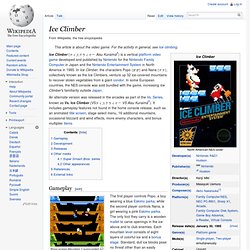
Is a vertical platform video game developed and published by Nintendo for the Nintendo Family Computer in Japan and the Nintendo Entertainment System in North America in 1985. In Ice Climber, the characters Popo (ポポ) and Nana (ナナ), collectively known as the Ice Climbers, venture up 32 ice-covered mountains to recover stolen vegetables from a giant condor. In some European countries, the NES console was sold bundled with the game, increasing Ice Climber's familiarity outside Japan. Gameplay[edit] Popo scales Mountain 1 surrounded by Toppies and a Nitpicker. Kid Icarus. Kid Icarus (光神話 パルテナの鏡, Hikari Shinwa: Parutena no Kagami?
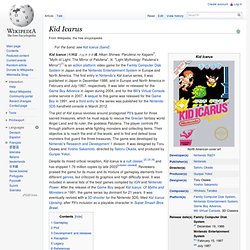
, "Myth of Light: The Mirror of Palutena", lit. "Light Mythology: Palutena's Mirror")[1] is an action platform video game for the Family Computer Disk System in Japan and the Nintendo Entertainment System in Europe and North America. Metroid (video game) Metroid (Japanese: メトロイド, Hepburn: Metoroido?)

Is an action-adventure video game, and the first entry in the Metroid series. It was co-developed by Nintendo's Research and Development 1 division and Intelligent Systems, and was released for the Famicom Disk System in Japan on August 6, 1986, and for the Nintendo Entertainment System in North America in August 1987, and in Europe in January 1988. The game was re-released for the Game Boy Advance in October 2004, and for the Wii Virtual Console in Europe in July 2007, in North America in August 2007, and in Japan in March 2008. Metroid was produced by Gunpei Yokoi, directed by Satoru Okada and Yoshio Sakamoto, and had music composed by Hirokazu Tanaka. Chronologically, Metroid takes place first in the fictional Metroid universe. Tanaka said he wanted to make a score that made players feel like they were encountering a "living organism" and had no distinction between music and sound effects.
Kirby's Adventure. Kirby's Adventure (星のカービィ 夢の泉の物語, Hoshi no Kābī: Yume no Izumi no Monogatari?
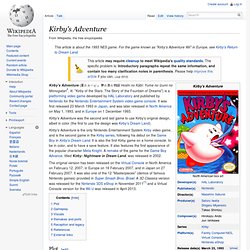
, lit. The Legend of Zelda (video game) The inaugural game of the Legend of Zelda series, it was first released in Japan as a launch title for the Family Computer Disk System peripheral.[6] More than a year later, North America and Europe received releases on the Nintendo Entertainment System in cartridge form, making the game the first home console title to include an internal battery for saving data.[7] In 1994, this version would be released back in Japan, now named The Hyrule Fantasy: Zelda no Densetsu 1 (THE HYRULE FANTASY ゼルダの伝説1?).
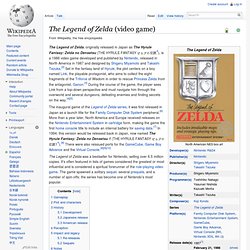
[8] There were also reissued ports for the GameCube, Game Boy Advance and the Virtual Console.[8][9][10] The Legend of Zelda was a bestseller for Nintendo, selling over 6.5 million copies. It's often featured in lists of games considered the greatest or most influential and is considered a spiritual forerunner of the role-playing video game. The game spawned a solitary sequel, several prequels, and a number of spin-offs; the series has become one of Nintendo's most popular.
Zelda II: The Adventure of Link. The game was highly successful at the time, and introduced elements such as Link's "magic meter" and the Dark Link character that would become commonplace in future Zelda games, although the role-playing elements such as experience points and the platform-style side-scrolling and multiple lives were never used again outside of the infamous CD-I games.
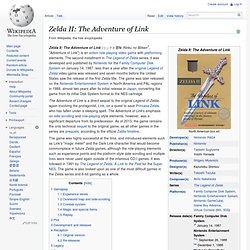
It was followed in 1991 by The Legend of Zelda: A Link to the Past for the Super NES. The game is also looked upon as one of the most difficult games in the Zelda series and 8-bit gaming as a whole. Gameplay[edit] Experience levels[edit] Overworld map and side-scrolling[edit] A screenshot of the overworld The Adventure of Link plays out in a two-mode dynamic. Link also enters this mode when attacked by wandering monsters. Mario Bros. Mario Bros.
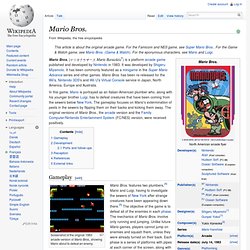
(マリオブラザーズ, Mario Burazāzu?) Is a platform arcade game published and developed by Nintendo in 1983. It was developed by Shigeru Miyamoto. It has been commonly featured as a minigame in the Super Mario Advance series and other games. Mario Bros. has been re-released for the Wii's, Nintendo 3DS's and Wii U's Virtual Console service in Japan, North America, Europe and Australia. In this game, Mario is portrayed as an Italian-American plumber who, along with his younger brother Luigi, has to defeat creatures that have been coming from the sewers below New York. Super Mario Bros. The game has been highly influential, popularizing the side-scrolling genre.
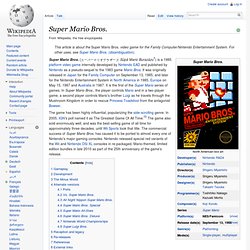
In 2005, IGN's poll named it as The Greatest Game Of All Time.[5] The game also sold enormously well, and was the best-selling game of all time for approximately three decades, until Wii Sports took that title. The commercial success of Super Mario Bros. has caused it to be ported to almost every one of Nintendo's major gaming consoles. Super Mario Bros.: The Lost Levels. Super Mario Bros.: The Lost Levels, originally released in Japan as Super Mario Brothers 2 (スーパーマリオブラザーズ2, Sūpā Mario Burazāzu Tsū?)
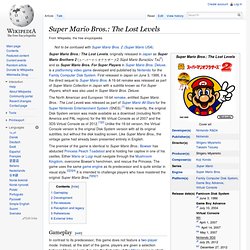
And as Super Mario Bros. For Super Players in Super Mario Bros. Deluxe, is a platforming video game developed and published by Nintendo for the Family Computer Disk System. First released in Japan on June 3, 1986, it is the direct sequel to Super Mario Bros. A 16-bit remake was released as part of Super Mario Collection in Japan with a subtitle known as For Super Players, which was also used in Super Mario Bros. Super Mario Bros. 2. Super Mario Bros. 2 (スーパーマリオUSA?
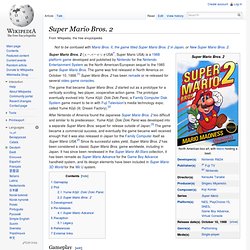
, Super Mario USA) is a 1988 platform game developed and published by Nintendo for the Nintendo Entertainment System as the North American/European sequel to the 1985 game Super Mario Bros. The game was first released in North America on October 10, 1988.[1] Super Mario Bros. 2 has been remade or re-released for several video game consoles. The game that became Super Mario Bros. 2 started out as a prototype for a vertically scrolling, two-player, cooperative-action game.
The prototype eventually evolved into Yume Kōjō: Doki Doki Panic, a Family Computer Disk System game meant to tie-in with Fuji Television's media technology expo, called Yume Kōjō (lit. Dream Factory).[2] Gameplay[edit] Super Mario Bros. 3. Gameplay[edit] Super Mario Bros. 3 introduced several suits to alter the character's abilities. For example, Mario can use the "Frog Suit" to swim more easily in water, but will move more slowly on land.
The player navigates through the game via two game screens: an overworld map and a level playfield. The overworld map displays an overhead representation of the current world and has several paths leading from the world's entrance to a castle. Paths connect to action panels, fortresses and other map icons, and allow players to take different routes to reach the world's goal. Super Mario Bros. 3 featured a world map that would be seen again in future Mario titles. Super Mario Bros. 3 includes a multiplayer option which allows two players to cooperatively play the game by taking turns at navigating the overworld map and accessing stage levels; the first player controls Mario, while the other controls Luigi. Development[edit] Reception[edit] Yoshi (video game) Yoshi, known as Yoshi's Egg (ヨッシーのたまご, Yosshī no Tamago?) In Japan and Mario & Yoshi in Europe and Australia, is a puzzle video game developed by Game Freak and published by Nintendo.
The game was released for the Nintendo Entertainment System and Game Boy consoles. Both versions were first released simultaneously in Japan on December 14, 1991, and then released in all other regions the following year. The objective of Yoshi is to match Yoshi egg shells to hatch them and prevent the four stacks, which pile up from the falling monsters, from growing too tall. The player characterMario swaps the stacks around such that the falling monsters will be eliminated by coming into contact with the blocks they match. Yoshi is a falling block game in which the player is given a playing field that is divided into four columns. In addition to the four different types of monsters, two halves of a Yoshi eggshell will also fall.
Yoshi sold 500,000 copies in its first day on sale.[15] Donkey Kong (video game) Donkey Kong Jr. Plot[edit] Mario (known as Jumpman in Donkey Kong) has captured Donkey Kong and placed him in a cage.[5] Donkey Kong Jr. must rescue his father from Mario by working his way through a series of stages. Mario attempts to stop DK Jr. by releasing animals and putting obstacles in his way.
When DK Jr. succeeds at the final level, Donkey Kong is freed and kicks Mario into the distance, leaving him to an unknown fate. Gameplay[edit] Like its predecessor, Donkey Kong, Jr. is an arcade-style platform game.